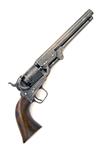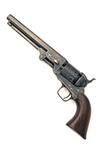Product Details
BY TRADITION THE PROPERTY OF Dr L.S JAMESON
COLT, LONDON
A CASED .36 PERCUSSION REVOLVER, MODEL '1851 LONDON NAVY', serial no. 38579,
for 1855, with octagonal 7 1/2in. London proved barrel, the top-flat signed 'ADDRESS COL. COLT LONDON', six-shot cylinder with roll-engraved naval scene, colour hardened open iron frame marked 'COLTS PATENT', iron grip-straps and trigger-guard, smooth walnut one-piece grip and articulated under-barrel rammer, the whole retaining strong traces of finish and all matching numbers, complete in its English market oak case lined and compartmented in green baize, the inside of lid with matching inked number and printed instruction label and retaining its iron double cavity mould, wood handled cleaning rod, period Hawksley bag-shaped flask, cap tin, oil bottle and case key, the outside of lid with inlet silver plaque inscribed 'DR L.S. JAMESON' and complete with volumes 1 & 2 of Ian Colvin's work 'The Life of Jameson'.
Provenance: Leander Starr Jameson was born to the Jameson family of Edinburgh on 9 February 1853, the son of Robert William Jameson (1805–1868), a Writer to the Signet, and Christian Pringle, daughter of Major-General Pringle of Symington House. Robert William and Christian Jameson had twelve children in total, of whom Leander Starr was the youngest.
Leander Starr Jameson's somewhat unusual name resulted from the fact that his father Robert William Jameson had been rescued from drowning on the morning of his birth by an American traveller, who fished him out of a canal or river with steep banks into which he had fallen while on a walk. The stranger named Leander Starr was promptly made a godfather of the baby, and given his name.
In due course, the Jameson family moved to London, living in Chelsea and Kensington. Leander Starr Jameson went to the Godolphin School in Hammersmith, where he did well in both lessons and games prior to his university education at University College Hospital, London. Passing his entrance examinations in January 1870, he distinguished himself as a medical student, becoming a Gold Medallist in materia medica. After qualifying as a doctor, he was made Resident Medical Officer at University College Hospital (M.R.C.S. 1875; M.D. 1877). After acting as house physician, house surgeon and demonstrator of anatomy, and showing promise of a successful professional career in London, his health broke down from overwork in 1878, and he went out to South Africa and settled down in practice at Kimberley. There he rapidly acquired a great reputation as a medical man, and, besides numbering President Kruger and the Matabele chief Lobengula among his patients, came much into contact with Cecil Rhodes.
Jameson was for some time the inDuna of the Matabele king's favourite regiment, the Imbeza. Lobengula expressed his delight with Jameson's successful medical treatment of his gout by honouring him with the rare status of inDuna. Although Jameson was a white man, he underwent the initiation ceremonies linked with this honour.
Jameson's status as an inDuna gave him advantages, and in 1888 he successfully exerted his influence with Lobengula to induce the chieftain to grant the concessions to the agents of Rhodes which led to the formation of the British South Africa Company; and when the company proceeded to open up Mashonaland, Jameson abandoned his medical practice and joined the pioneer expedition of 1890. From this time his fortunes were bound up with Rhodes' schemes in the north. Immediately after the pioneer column had occupied Mashonaland, Jameson, with F. C. Selous and A. R. Colquhoun, went east to Manicaland and was instrumental in securing the greater part of the country, to which Portugal was laying claim, for the Chartered Company. In 1891 Jameson succeeded Colquhoun as Administrator of Mashonaland. In 1893, Jameson was a key figure in the First Matabele War and involved in incidents that led to the massacre of the Shangani Patrol.
In 1895, Jameson led about 500 of his countrymen in what became known as the Jameson Raid against the Boers in southern Africa. The Jameson Raid was later cited by Winston Churchill as a major factor in bringing about the Boer War of 1899 to 1902. But the story as recounted in Britain was quite different. The British defeat was interpreted as a victory and Jameson was portrayed as a daring hero and celebrated for his heroism, dignity, stoicism and courage in the face of the disaster of the failed raid, for which he was wrongfully made a scapegoat.
In 1895, Jameson assembled a private army outside the Transvaal in preparation for the violent overthrow of the Boer government. The idea was to foment unrest among foreign workers (Uitlanders) in the territory, and use the outbreak of open revolt as an excuse to invade and annex the territory. In November 1895, a piece of territory of strategic importance, the Pitsani Strip, part of the Bechuanaland Protectorate and bordering the Transvaal, was ceded to the British South Africa Company by the Colonial Office, overtly for the protection of a railway running through the territory. Cecil Rhodes, the Prime Minister of the Cape Colony and managing director of the Company was eager to bring South Africa under British dominion, and encouraged the disenfranchised Uitlanders of the Boer republics to resist Afrikaner domination. Rhodes hoped that the intervention of the Company's private army could spark an Uitlander uprising, leading to the overthrow of the Transvaal government. Rhodes' forces were assembled in the Pitsani Strip for this purpose. Joseph Chamberlain informed Salisbury on Boxing Day that an uprising was expected, and was aware that an invasion would be launched, but was not sure when. The subsequent Jameson Raid was a debacle, leading to the invading force's surrender. Chamberlain, at Highbury Hall, his home in Birmingham, received a secret telegram from the Colonial Office on 31 December informing him of the beginning of the Raid. Though sympathetic to the ultimate goals of the Raid, Chamberlain was uncomfortable with the timing of the invasion and remarked "if this succeeds it will ruin me. I'm going up to London to crush it". He swiftly travelled by train to the Colonial Office, ordering Sir Hercules Robinson, Governor of the Cape Colony, to repudiate the actions of Jameson and warned Rhodes that the Company's Charter would be in danger if it were discovered that the Cape Prime Minister were involved in the Raid. The prisoners were returned to London for trial, and the Transvaal government received considerable compensation from the Company. Jameson was tried in England for leading the raid; during that time he was lionised by the press and London society.
The Jameson Raiders arrived in England at the end of February, 1896 to face prosecution under the Foreign Enlistment Act 1870 styled "R. v Jameson, Willoughby and others". There were some months of investigations initially held at Bow Street, following which the "trial at bar" (a legal procedure reserved only for very important cases) began on 20 June 1896, at the High Court of Judicature. The trial lasted seven days, following which Dr Jameson was found guilty and sentenced to imprisonment as a first-class misdemeanant for fifteen months. He was, however, released from Holloway in the following December on account of illness.
During the trial of Jameson, Rhodes' solicitor, Bourchier Hawksley, refused to produce cablegrams that had passed between Rhodes and his agents in London during November and December 1895. According to Hawksley, these demonstrated that the Colonial Office 'influenced the actions of those in South Africa' who embarked on the Raid, and even that Chamberlain had transferred control of the Pitsani Strip to facilitate an invasion. Nine days before the Raid, Chamberlain had asked his Assistant Under-Secretary to encourage Rhodes to "hurry up" because of the developing Venezuela Crisis of 1895. In June 1896, Chamberlain, British Colonial Secretary of the day, offered his resignation to Lord Salisbury, having shown the Prime Minister one or more of the cablegrams implicating him in the Raid's planning. Salisbury refused to accept the offer, possibly reluctant to lose the government's most popular figure. Salisbury reacted aggressively in support of Chamberlain, supporting the Colonial Secretary's threat to withdraw the Company's charter if the cablegrams were revealed. Accordingly, Rhodes refused to reveal the cablegrams, and as no evidence was produced showing that Chamberlain was complicit in the Raid's planning, the Select Committee appointed to investigate the events surrounding the Raid had no choice but to absolve Chamberlain of all responsibility.
Jameson had been Administrator General for Matabeleland at the time of the Raid and his intrusion into Transvaal depleted Matabeleland of many of its troops and left the whole territory vulnerable. Seizing on this weakness, and a discontent with the British South Africa Company, the Matabele revolted in March 1896 in what is now celebrated in Zimbabwe as the First War of Independence – the Second Matabele War. Hundreds of white settlers were killed within the first few weeks and many more would die over the next year and a half at the hands of both the Matabele and the Shona. With few troops to support them, the settlers had to quickly build a laager in the centre of Bulawayo on their own. Against over 50,000 Matabele held up in their stronghold of the Matobo Hills as the settlers mounted patrols under Burnham, Baden-Powell, and Selous. After the Matabele laid down their arms, the war continued until October 1897 in Mashonaland.
Please click HERE to view Terms & Conditions.
Estimate £3,000-5,000









